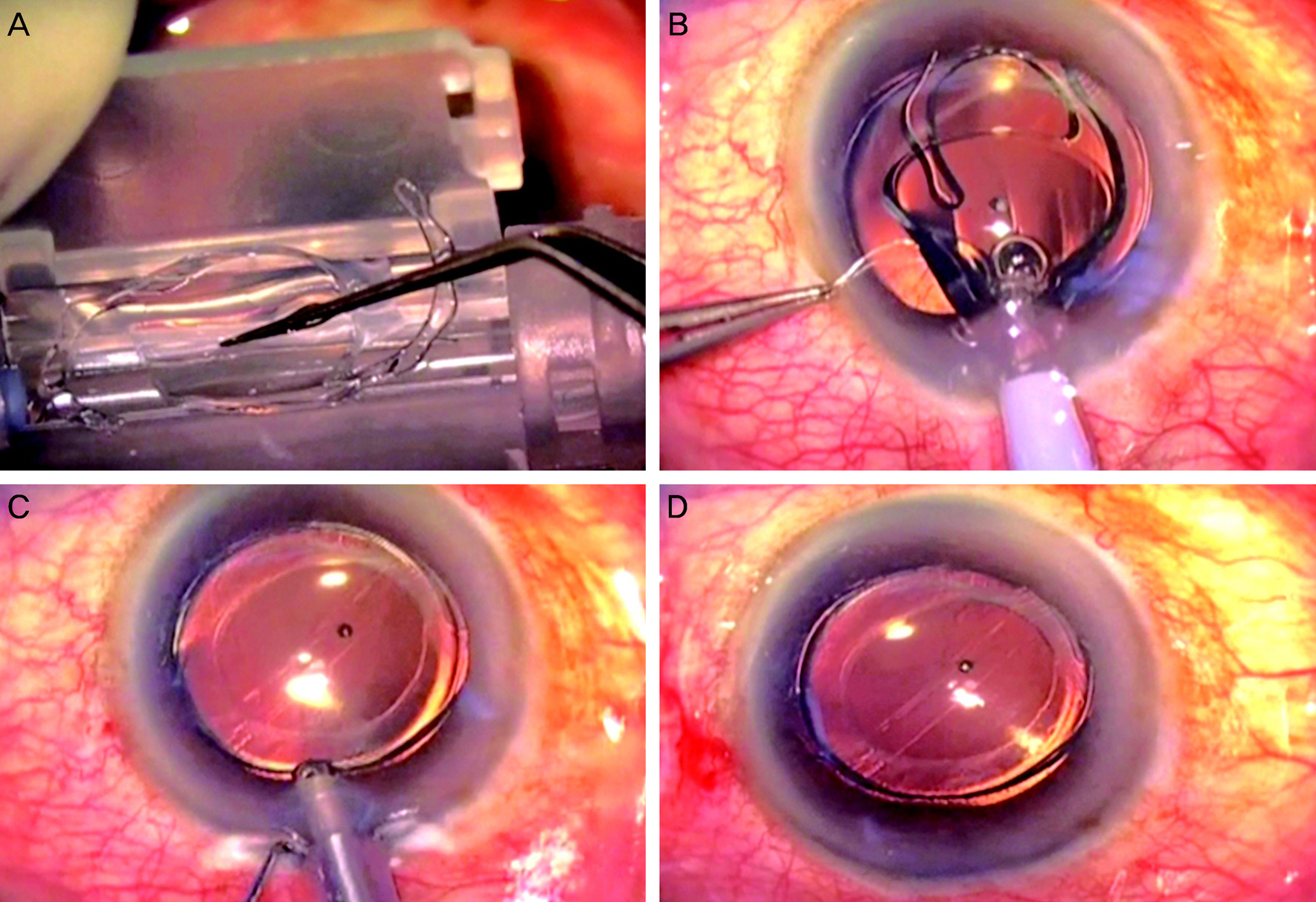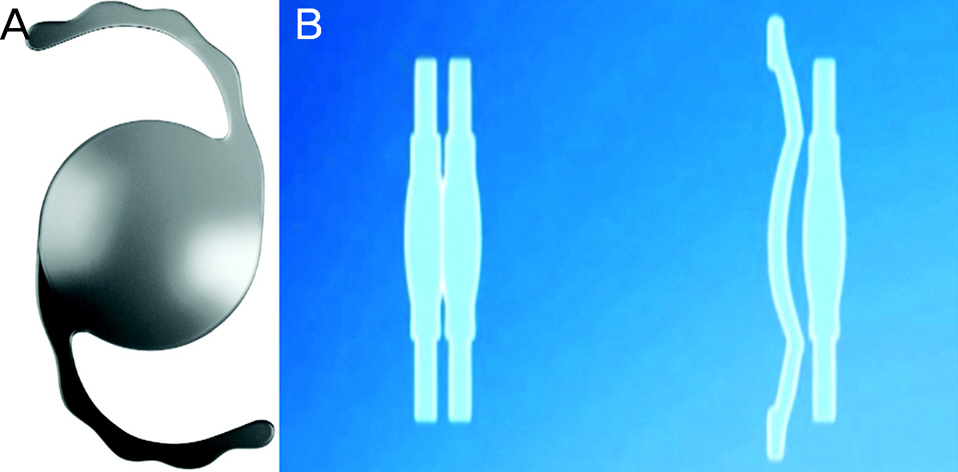J Korean Ophthalmol Soc.
2014 Dec;55(12):1890-1894. 10.3341/jkos.2014.55.12.1890.
A Case of Corrected Residual Refractive Error after Cataract Surgery with the Sulcoflex Piggyback IOL
- Affiliations
-
- 1Department of Ophthalmology, Pusan National University School of Medicine, Busan, Korea. jongsool@pusan.ac.kr
- 2BGN Eye Clinic, Busan, Korea.
- KMID: 2338981
- DOI: http://doi.org/10.3341/jkos.2014.55.12.1890
Abstract
- PURPOSE
To report a case of corrected residual refractive error after cataract surgery with sulcoflex piggyback intraouclar lens (IOL).
CASE SUMMARY
A 77-year-old man was diagnosed as having hypermature cataract in the right eye and his corrected visual acuity in the same eye was hand-motion before surgery. Refractive error was +9.0 diopter (D) 6 months after conventional cataract surgery in the right eye. The authors performed additional cataract surgery using a piggyback method inserting a +10.0 D IOL in the ciliary sulcus. Four weeks after surgery, his refractive error was -1.25 D, visual acuity increased to 120/200 and 60/200 (with and without correction, respectively). No complication was observed during follow-up time and the patient was satisfied with his results.
CONCLUSIONS
Correction of residual refractive error after cataract surgery with sulcoflex piggyback IOL is safe and effective.
Figure
Reference
-
References
1. West SK, Valmadrid CT. Epidemiology of risk factors for age-related cataract. Surv Ophthalmol. 1995; 39:323–34.2. Ridley H. Intra-ocular acrylic lenses after cataract extraction. 1952. Bull World Health Organ. 2003; 81:758–61.3. Ayala MJ, Pérez-Santonja JJ, Artola A, et al. Laser in situ keratomileusis to correct residual myopia after cataract surgery. J Refract Surg. 2001; 17:12–6.
Article4. Jin GJ, Crandall AS, Jones JJ. Changing indications for and improving outcomes of intraocular lens exchange. Am J Ophthalmol. 2005; 140:688–94.
Article5. Piñero DR, Ayala Espinosa MJ, Alió JL. LASIK outcomes following multifocal and monofocal intraocular lens implantation. J Refract Surg. 2010; 26:569–77.
Article6. Jin GJ, Crandall AS, Jones JJ. Intraocular lens exchange due to incorrect lens power. Ophthalmology. 2007; 114:417–24.
Article7. Fernández-Buenaga R, Alió JL, Pinilla-Cortés L, Barraquer RI. Perioperative complications and clinical outcomes of intraocular lens exchange in patients with opacified lenses. Graefes Arch Clin Exp Ophthalmol. 2013; 251:2141–6.
Article8. Gayton JL, Sanders VN. Implanting two posterior chamber intraocular lenses in a case of microphthalmos. J Cataract Refract Surg. 1993; 19:776–7.
Article9. Gayton JL, Sand, ers V, Van der Karr M, Raanan MG. Piggybacking intraocular implants to correct pseudophakic refractive error. Ophthalmology. 1999; 106:56–9.
Article10. Dagres E, Khan MA, Kyle GM, Clark D. Perioperative complications of intraocular lens exchange in patients with opacified Aqua-Sense lenses. J Cataract Refract Surg. 2004; 30:2569–73.
Article11. El Awady HE, Ghanem AA. Secondary piggyback implantation versus IOL exchange for symptomatic pseudophakic residual ametropia. Graefes Arch Clin Exp Ophthalmol. 2013; 251:1861–6.
Article12. Leysen I, Bartholomeeusen E, Coeckelbergh T, Tassignon MJ. Surgical outcomes of intraocular lens exchange: five-year study. J Cataract Refract Surg. 2009; 35:1013–8.13. Hassan Z, Szalai E, Berta A, et al. Assessment of tear osmolarity and other dry eye parameters in post-LASIK eyes. Cornea. 2013; 32:e142–5. doi: 10.1097/ICO.0b013e318290496d.
Article14. Argento CJ, Cosentino MJ. Comparison of optical zones in hyperopic laser in situ keratomileusis: 5.9 mm versus smaller optical zones. J Cataract Refract Surg. 2000; 26:1137–46.
Article15. Llorente L, Barbero S, Merayo J, Marcos S. Total and corneal optical aberrations induced by laser in situ keratomileusis for hyperopia. J Refract Surg. 2004; 20:203–16.
Article16. Varley GA, Huang D, Rapuano CJ, et al. LASIK for hyperopia, hyperopic astigmatism, and mixed astigmatism: a report by the American Academy of Ophthalmology. Ophthalmology. 2004; 111:1604–17.17. Fernández-Buenaga R, Alió JL, Pérez Ardoy AL, et al. Resolving refractive error after cataract surgery: IOL exchange, piggyback lens, or LASIK. J Refract Surg. 2013; 29:676–83.
Article18. Solebo LA, Eades Walker RJ, Dabbagh A. Intraocular lens exchange for pseudophakic refractive surprise due to incorrectly labeled intraocular lens. J Cataract Refract Surg. 2012; 38:2197–8.
Article19. Gayton JL, Apple DJ, Peng Q, et al. Interlenticular opacification: clinicopathological correlation of a complication of posterior chamber piggyback intraocular lenses. J Cataract Refract Surg. 2000; 26:330–6.
Article20. Iwase T, Tanaka N. Elevated intraocular pressure in secondary piggyback intraocular lens implantation. J Cataract Refract Surg. 2005; 31:1821–3.
Article21. Davison JA. Capsule contraction syndrome. J Cataract Refract Surg. 1993; 19:582–9.
Article22. Kodjikian L, Gain P, Donate D, et al. Malignant glaucoma induced by a phakic posterior chamber intraocular lens for myopia. J Cataract Refract Surg. 2002; 28:2217–21.
Article23. Chang DF, Masket S, Miller KM, et al. Complications of sulcus placement of single-piece acrylic intraocular lenses: recommendations for backup IOL implantation following posterior capsule rupture. J Cataract Refract Surg. 2009; 35:1445–58.24. Khan MI, Muhtaseb M. Performance of the Sulcoflex piggyback intraocular lens in pseudophakic patients. J Refract Surg. 2011; 27:693–6.
Article25. Falzon K, Stewart OG. Correction of undesirable pseudophakic refractive error with the Sulcoflex intraocular lens. J Refract Surg. 2012; 28:614–9.
Article
- Full Text Links
- Actions
-
Cited
- CITED
-
- Close
- Share
- Similar articles
-
- Refractive Change and Complications Following Single or Temporary Piggyback Intraocular Lens Implantation in Infancy
- Refractive Changes after Removal of Anterior IOLs in Temporary Piggyback IOL Implantation for Congenital Cataracts
- Cataract Surgery Using Piggyback Method in Patient With Nanophthalmos
- The Difference in Post-operative Refractive Error between In-the-bag and Sulcus Intraocular Lens Implantation
- Intraocular Lens Power Calculation for Cataract Surgery in Patients who had Previous Refractive Surgery (RK 1 Case, PRK 3 Cases, LASIK 1 Case)



